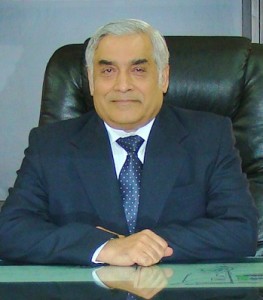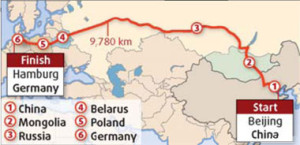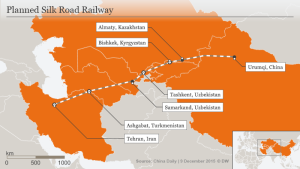क्या रूस से मुंबई तक युग परिवर्तक उत्तर – दक्षिण यातायात कोरिडोर वाणिज्य बुद्धिमत्ता के बिना फेल हो जाएगा ?
इस दशक के तीन बड़ी युग परिवर्तक ट्रांसपोर्ट परियोजनाओं मैं चीन पकिस्तान का ग्वादर सी पैक कोरिडोर , चीन का यूरोप से रेल कोरिडोर व् भारत – ईरान- रूस का उत्तर दक्षिण कॉरिडोर हैं . चीन से चल कर मास्को होती हुयी ९८२० किलोमीटर पंद्रह दिन मैं चल कर पहली रेल गाड़ी जर्मनी के हैम्बर्ग शहर इस वर्ष जून मास मैं पहुँच गयी .
चीन से ईरान की रेल लाइन पर भी ६२०० किलोमीटर चल कर पहली गाडी फरवरी २०१६ मैं तेहरान पहुँच गयी जिससे चीन से ईरान का सफ़र तीस दिन कम हो गया .
आशा है कि अगले वर्ष के मध्य तक भारत के मुंबई से रूस के मास्को व् फ़िनलैंड तक जाने वाला उत्तर दक्षिण कॉरिडोर भी चालू हो जाएगा .
भारत की ईरान की चाह्बहार बंदरगाह व् उत्तर दक्षिण कोरिडोर की पहल सराहनीय है अन्यथा भारत चीन से बहुत पिछड़ जाता . रक्षा की दृष्टि से भी पाकिस्तान को बिना छूए सेंट्रल एशिया के देशों तक पहुंचना भारत के लिए राजनितिक दृष्टि से आवश्यक है. परन्तु भारत – रूस – ईरान की परियोजनाएं वाणिज्य करारों व् विश्लेषण के न होने के कारण फेल भी हो सकती हैं .इसलिए इन योजनाओं का वाणिज्यिक विश्लेषण आवश्यक है और
भारत को इसमें बड़ी पहल करनी होगी .
नार्थ साउथ कोरिडोर मुंबई से कंटेनर को समुद्री जहाज से ईरान के बन्द्र्बास बंदरगाह तक ले जाएगा . यहाँ से रेल द्वारा यह ईरान के आखिरी शहर तक जाएगा .वहां इसको रूसी रेल गेज की अजर्बिजान देश की रेल से मास्को तक ले जाया जाएगा . इसको फ़िनलैंड से भी जोड़ा जाएगा जहाँ से इसे यूरोप ले जाया जा सकता है . इससे स्वेज नहर के भीडभाड वाले समुद्री रास्ते को छोड़ कर अभी चालीस दिन मैं होने वाला सफ़र मात्र चौदह दिन मैं संभव हो सकेगा और एक कंटेनर भेजने पर ३०- ४० % लागत भी कम हो जाएगी . एक अनुमान के अनुसार इस रूट पर ४ मिलियन टन से प्रारंभ हो कर २० – २५ मिलियन टन सामान जाएगा.रेल के बजे ट्रक से भी सामान जा सकता है .
कागज़ पर तो यह परियोजना बड़ी अच्छी लगती है . परन्तु इस को सफल बनाने के लिए जो वाणिज्यिक कदम उठाने चाहिए वह अभी तक कहीं नहीं दीख रहे.
पहले तो यह परियोजना सा २००० मैं सोची गयी थी . अब इसके सन २०१७ मैं शुरू होने के आसार हैं .इस देर से दुखी होकर रूस की बड़ी कंपनी वेगना ने ५००००० डालर लगा कर भी साथ छोड़ दिया . ट्रायल रन मैं ईरान मैं रेल वेगनों की बहुत कमी पाई गयी और छः दिन तक कंटेनर ईरान मैं रुके रहे . .इसी तरह कस्टम चेक के लिए कोई समझौता नहीं हुआ है .रूस से चल कर यदि निरंतर ट्रक नहीं चलता रहे तो इस परियोजना का लाभ नहीं होगा . ईरान मैं भ्रष्टाचार की भी बहुत शिकायतें मिली हैं .रूस मैं भी भ्रष्टाचार पहले बहुत बढ़ गया था .समुद्री जहाज मैं एक बार माल लोड हो गया तो फिर मंजिल पर ही उतरता है .इसमें सीमाओं पर भ्रष्टाचार की बाधाएं बहुत कम होती हैं .
वैसे भी ट्रक से सामान भेजना समुद्री जहाज से सामान भेजने से बहुत महंगा होता है. चीन से यूरोप रेल गाड़ियों के के लिए माल नहीं मिल रहा है .यही हाल इस परियोजना का हो सकता है . अभी तो लग रहा है एक तरफ से कंटेनर खाली ही आयेंगे जिससे लगत बढ़ जायेगी .
यदि रूस एक सब देशों की मिला कर एक संस्था बना सके जिसमें संयक्त कस्टम व् पोलिस भी हो तो यह परियोजना सफल हो सकती है . इसी तरह से भारत मैं बड़े स्टील प्लांट लगाते हुए पहले खाली डिब्बों के रूट को देखा जाता है . इसी को अंतर्राष्ट्रीय स्तर पर करना होगा .
इस अब को करने के लिए सब देशों के विशेषज्ञों की समिति बनानी होगी . सबसे अच्छा होगा यदि सब देश मिल कर एक देश की किसी बड़ी कम्पनी को यह पूरा काम सौंप दें . भारत इस के लिए सबसे उपयुक्त देश है . भारत की राइट्स कंपनी इस काम मैं पारंगत है . परन्तु इसे भी बहुत देशों से एक साथ मिल कर काम करने का अनुभव नहीं है .इसके लिए राजनितिक परिपक्विता की आवश्यकता होगी . और किसी देश के पास ऐसी अनुभवी कंपनी नहीं है .परन्तु इसके लिए राजनितिक पहल रूस या ईरान को लेनी होगी . ईरान मैं इस परियोजना का हेड क्वार्टर है .
भारत की मदद से बन रहे ईरान के चाह्भार बदरगाह की भी यह समस्या है की उसे तेहरान से रेल से जोड़े बिना पूरा लाभ नहीं मिल सकता क्योंकि माल की खपत तेहरान मैं ही होती है .
इसलिए अब यह आवश्यक है की भारत इस परियोजना के वाणिज्य समझौते शुरू करने की पहल करे .
हिन्दू अख़बार की खबर नीचे पढ़ें
North-South corridor in the doldrums
Vladimir Radyuhin
THE NORTH-SOUTH Transport Corridor is losing out to traditional trade routes from Asia to Europe despite geographic advantages and multi-million investment, businessmen and officials from India, Russia, and Iran said. They urged the member-states to take urgent steps to rescue the project.
“Further delays in resolving problems facing the North-South corridor may kill the project,” Minister of Industry, Transport and Communication of Astrakhan Region Sergei Terskov told a one-day conference, “North-South Corridor,” organised by the Indian Business Alliance in Russia (IBA) and the government of Astrakhan Region.
When India, Russia, and Iran signed an inter-governmental agreement in September 2000 to establish the North-South Transport Corridor (NSTC) many experts predicted a bright future for the new trade route.
“With the launching of [the] NSTC, the Asia-Europe transport corridor through the Suez Canal lost 10 percent of its traffic,” said Mr. Terskov. Belarus, Kazakhstan, Tajikistan, Azerbaijan, Armenia, Syria, and Oman have since joined the project. And, Turkey, Bulgaria, Ukraine, and Kyrgyzstan have applied to sign in.
The North-South fast-track transport corridor held out the promise of cutting shipment time from India to Europe by 10 to 15 days compared with the traditional route and reduce transport costs by about 30 per cent. Goods leaving Kochi and Mumbai were shipped to the Iranian port of Bandar Abbas, where they were loaded onto trucks, and hauled to Anzali, Iran’s port on the Caspian Sea, from where they were carried by sea to Russian, Turkmenian or Kazakhstan ports.
The new land-and-sea trade route’s projected capacity is 20 million tonnes of cargo a year by 2010, but initial enthusiasm of traders and transport companies has given way to disappointment. Red tape, corruption, and lack of government support have all but eroded the advantages of the route.
Russia’s Vagna Shipping company, pioneer of the North-South corridor, pulled out of the project in 2003 with a net loss of $500,000. Operators say practically all cargo from India to Europe today is shipped through the Suez Canal.
It may take up to seven days to clear transit cargo at Bandar Abbas, and another five to seven days at Astrakhan. As a result, the minimal shipping time of 18-20 days from Mumbai to Astrakhan in most cases is stretched to 40-50 days. The cost rises accordingly. Moreover, the cargo has to be reloaded twice — in Bandar Abbas and Astrakhan, to avoid moving back empty containers, as there is little return cargo.
A case study presented by India’s Mega Trend Co. Ltd., which services the route via the Suez Canal, shows that it will actually take longer and cost more to ship cargo through the North-South corridor.
Many blame the participating governments for the problems of the new transport route.
“The founding states took the right step setting up the North-South Transport Corridor, but they have failed to follow up with measures to facilitate traffic along the new route,” said Astrakhan Region’s Transport Minister Terskov.
A coordination council set up by the member-states to deal with the NSTC’s problems has been of little help so far, Mr. Terskov said. “The Coordination Council is not delivering,” he says. “It should meet more often, at least twice a year, identify and remove bottlenecks and hurdles, and lobby for preferences for the new route.”
Next month the Coordination Council will meet in New Delhi. It is hoped it will finally wake up to the problems facing the North-South transport route, which has truly strategic importance for India, Russia, and Iran.




